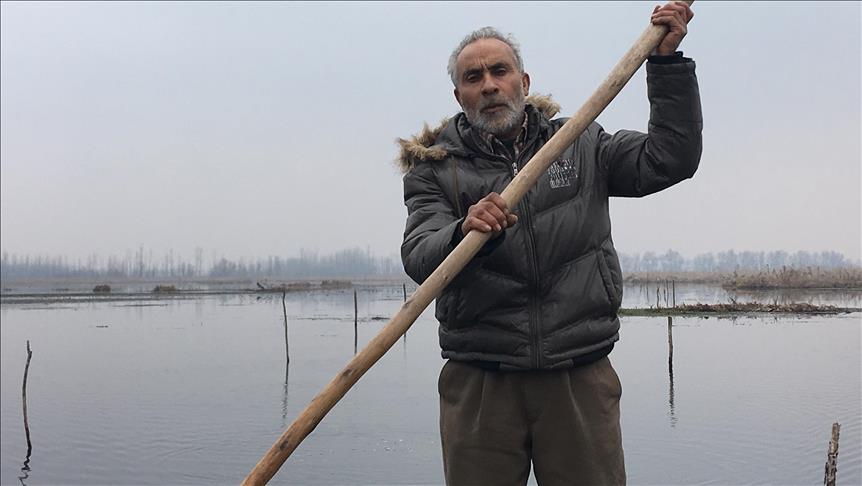Kashmir's wetlands, migratory birds face uncertainty
Lakes that provided winter refuge for thousands of birds shrinking from lack of care
 Ghulam Ahmad Dar in the Hokersar Wetland
Ghulam Ahmad Dar in the Hokersar Wetland
By Zahid Rafiq
SRINAGAR, Jammu and Kashmir
Amid the gloom and bleakness of the harsh Kashmiri winter, hundreds of thousands of migratory birds bring a splash of color to the skies as they head to the region’s wetlands.
For centuries, countless species have flown south to Kashmir from Siberia, Japan, Europe and China to enjoy the warmer climate and ice-free waters at the base of the Himalayas.
Kashmir’s wetlands attract up to a million birds every winter, according to wildlife officials.
“They start to arrive in October and these migrations are an astounding feat of nature,” Wildlife Warden Rouf Zargar told Anadolu Agency.
“This is the Asian flyway zone and birds fly for days, navigating with the help of stars, open moonlight and mountain peaks and reach here.”
Among the species to head for more than 400 areas of open water are tufted ducks, gadwalls, brahminy ducks, garganeys, mallards and common mergansers.
At Hokersar lake, the biggest wetland in Kashmir, hundreds of moorhens bob quiet on clear shallow waters. The slightest disturbance sees them take flight for hiding spots in the tall grasses.
Old, green-painted wooden towers stand distant in the waters, built to provide observation points for birdwatchers.
However, the twitchers are no longer coming to Kashmir in the numbers they once did.
“We used to have far more birdwatchers many years ago than we have these days,” Ghulam Ahmad Dar, a warden at Hokersar, said. “Now there are hardly any.”
Drying wetlands
As Dar, 51, propels a narrow boat through the wetland’s thinning waterways, he recalls a time of plentiful bird life and tourism -- as well as waterways that stretched much further than today.
“It is not a century ago that I speak of, but 25 or 30 years ago when I first came for work here,” he said. “Now all the wetlands are drying and so many species of birds don’t come here anymore.
“The water used to come up to my chest earlier but now it dies at my calves.”
Official figures confirm Dar’s assessment.
In 1989, the Bombay Natural History Society recorded 64 species of bird in Kashmir’s wetlands.
Two years ago, the Asian Waterbird Census recorded 33 species in 13 wetlands across Kashmir. More than 94 percent of these were in the wetlands of Hokersar and Shallabug.
The decline is attributed to the neglectful condition of the wetlands.
Government apathy, rapid urbanization and human encroachment are cited as the main sources of the wetlands’ poor condition.
According to the Department of Wetlands, the active area of Hokersar has shrunk from almost 14 square kilometers (5 square miles) to less than 6 sq km (2 sq miles) in a few decades.
Zargar said a lack of funds was the biggest problem facing the region.
Political will
“The wetlands are primarily there for the absorption of excess water in the case of floods,” he said.
“Then comes its purpose of serving the avian population and the flora and fauna. The gathering of the silt is a real problem that will need a lot of money to be countered and our department does not have that kind of money."
Water levels in Hokersar have fallen from nearly 2 meters (7 feet) to 80 centimeters (2 and a half feet), reducing the availability of fish and other food sources such as lotus stems.
Shakil Romshoo, head of earth sciences at the University of Kashmir, has studied the condition of Kashmir’s waters and concluded that they were severely affected by massive floods in 2014.
“But, they can be restored and they must be,” he told Anadolu Agency.
“These wetlands have tremendous hydrological importance and one cannot restore them through unscientific methods -- it is not the same as dredging a river.”
Romshoo said political will would prove to be the most important element in saving Kashmir’s wetlands.
However, the regional government seems to be heading in the opposite direction.
Officials have earmarked Narkara wetland for the construction of a management school despite stiff opposition from locals.
As the wetlands quietly wither, the seasons of Kashmir’s migratory birds seem numbered.
Anadolu Agency website contains only a portion of the news stories offered to subscribers in the AA News Broadcasting System (HAS), and in summarized form. Please contact us for subscription options.

